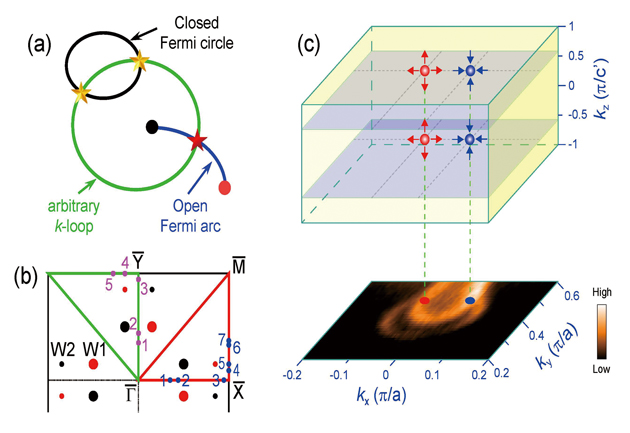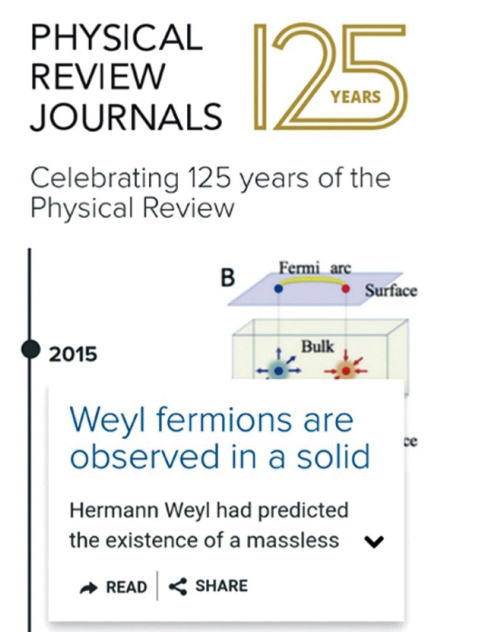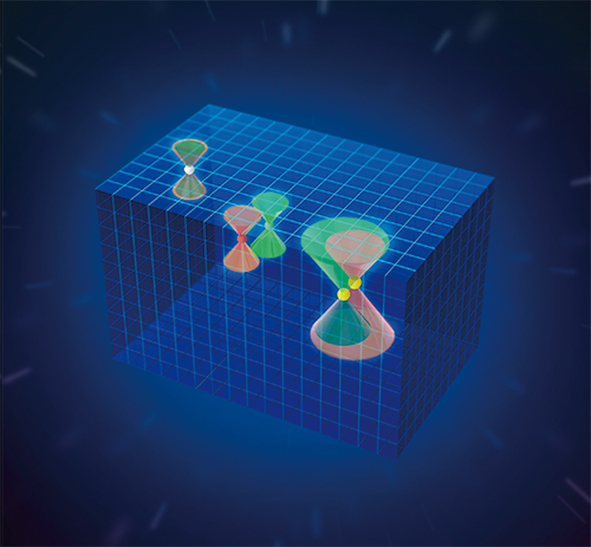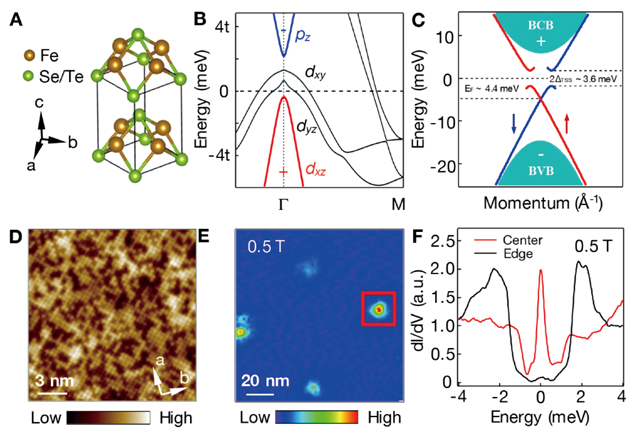Novel Topological Orders
In the field of topological states of matter, scientists at the Institute of Physics (IOP), CAS predicted a series of novel topological orders of matter and verified the theoretical predictions in a series of novel materials.
In 2009, IOP physicists predicted Bi2Te3, Bi2Se3, and Sb2Te3 as three-dimension topological insulators. Later experimentally validated, these materials have now become the most widely studied topological insulators.
During the period from 2012 to 2014, IOP scientists theoretically predicted and experimentally verified two Dirac semimetals, namely Na3Bi and Cd3As2, establishing the semimetal state as a new state of matter.
Prediction and Observation of Quantum Anomalous Hall Effect
In 2010, they proposed that Cr- or Fe-doped thin films of materials based on Bi2Te3, a magnetic topological insulator, could be an ideal system for achieving quantum anomalous Hall effect. Two years later, they successfully verified their own prediction by experimentally observing this effect in thin films of Cr-doped (Bi,Sb)2Te3, working in cooperation with colleagues from Tsinghua University.

The joint team of IOP and Tsinghua University successfully observed quantum anomalous Hall effect in thin films of Cr-doped (Bi,Sb)2Te3. (Image by courtesy of IOP)
Prediction and Observation of Chiral-Anomaly-Induced Negative Magnetoresistance in 3D Weyl Semimetal TaAs
Later in 2015, IOP scientists further predicted that TaAs materials could be a family of 3D Weyl semimetals, and later observed chiral-anomaly-induced negative magnetoresistance in this family of materials.
As proposed by German scientist H. Weyl in 1929, the massless solution of the Dirac equation represents a pair of chiral particles, later named as Weyl fermions. However, Weyl fermion as a fundamental particle remains elusive after more than eight decades, and verifying its existence has become a challenging task in the physical world. Later developments in topological insulator inspired new strategies for the search of these evasive particles, predicting its possible existence in an exotic condensed matter called Weyl semimetal.

Three groups at the Institute of Physics, CAS predicted and experimentally verified the existence of Weyl fermions in the form of semimetal, a type of exotic condensed matter. (Image by IOP)
In the 2010s, physicists at IOP and their collaborators predicted via theoretical calculation that the TaAs family, a type of non-magnetic and non-centrosymmetric transition-metal monoarsenide, could actually be Weyl semimetals. A third IOP group successfully grew crystals of this compound, and observed negative magnetoresistance in this material, agreeing with the prediction by Weyl. Another IOP group, working in cooperation with collaborators, observed the 3D electron energy spectrum and Fermi arc. The teams eventually identified the “phantom particle” that has stayed obscure for 80 years.

The experimental observation of Weyl fermions by IOP was listed among the 49 achievements selected by the Physical Review Journals in celebration of the 125th anniversary of the Physical Review.
This discovery was ranked into the greatest 10 physical breakthroughs of 2015 by the Institute of Physics, UK, and the eight highlight works of the same year by the American Physical Society.
Discovery of three-component fermions
According to the Standard Model, the mainstream theory to explain matter in the cosmos as a result from the Big Bang, the elementary particles of matter can be divided into bosons and fermions. As a result from Lorentz invariance, an effect in quantum field theory, only three types of fermions are possible to exist in the cosmos: the Dirac, Weyl and Majorana fermions. Among them, the Dirac fermion has four components, whilst Weyl and Majorana fermions have two – no fermion of three components exists in the cosmos, the theories said.

The existence of quasi-fermions in solid materials, or the “solid cosmos.” Shown here are three types of fermions, respectively of four (left), two (middle), and three (right) degrees of degeneracy. (Image: Courtesy of Institute of Physics, CAS)
In condensed-matter systems, however, things could be different. Unlike in the “real” cosmos, in crystals, Lorentz invariance is not applicable due to the special symmetry of its inner space, and this gives rise to the possibility to observe special states that might not exist in the “real” cosmos.

Crystal structure and band structure of MoP along the Γ–A line in the Brillouin zone. a, Schematics of Dirac and Weyl fermions, and the newly discovered fermion, which have band crossing points with four- (Dirac point, DP), two- (Weyl point, WP) and three-fold (triply degenerate point, TP) degeneracies, respectively. b, Three-dimensional crystal structure of MoP. The yellow plane indicates the mirror plane Mz. c, Top view of the lattice showing the C3z rotation symmetry with respect to molybdenum (brown spheres) or phosphide (green spheres) and the My mirror plane (horizontal red line). d, Three-dimensional bulk Brillouin zone (black) and the projected (001) surface Brillouin zone (blue), with high-symmetry points indicated. e, f, Calculated band structures along Γ–A (in terms of the energy E relative to the Fermi energy EF) without (e) and with (f) SOC. The filled circles at the crossing points indicate the triply degenerate points. The curves with mixed colors represent doubly degenerate bands and those with uniform color represent non-degenerate bands.
Whether or not exist, three-component fermions have been proposed by physicists as low-energy, long-wavelength quasi-particle excitations in condensed-matter systems. By using angle-resolved photoemission spectroscopy, IOP researchers and their cooperators successfully demonstrated the existence of a triply degenerate point in the electronic structure of crystalline molybdenum phosphide. Such quasi-particle excitations near a triply degenerate point were identified as three-component fermions, a type of fermions beyond the conventional Dirac–Weyl–Majorana classification.
Discovery of Majorana Bound State in Fe-based Superconductor
Despite breakthroughs in various fantastic fermionic excitations in “solid cosmos” like crystals, including the above-mentioned three-component fermions, the search for Majorana fermion – a special particle whose antiparticle is itself – or bound state in topological superconductors remained unsettled, until another team at IOP made the difference in 2018.

Band structure and vortex cores of FeTe0.55Se0.45
In 1937, Italian theoretical physicist Ettore Majorana decomposed Dirac equation into the real and imaginary parts, and obtained Majorana equation, which described the motion of “Majorana fermion.”
In collaboration with scientists at Tokyo University, IOP scientists performed ultra-high resolution ARPES experiments on FeTe0.55Se0.45, and for the first time clearly observed a superconducting topological surface state. Later, inside a vortex core of FeTe0.55Se0.45, they successfully observed a strong zero-bias peak, a sign regarded as a hallmark of a Majorana bound state.
This marks the first clear, repeatable observation of a pure Majorana bound state.

